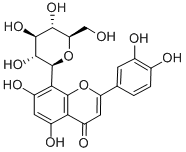
Product Details;
CasNo: 28608-75-5
Molecular Formula: C21H20O11
Appearance: yellow powder
|
28608-75-5 Name |
|
|
Name |
ORIENTIN |
|
Synonym |
2-(3,4-Dihydroxyphenyl)-8-beta-D-glucopyranosyl-5,7-dihydroxy-4H-1-benzopyran-4-one;ORIDONIN (RG);4H-1-Benzopyran-4-one, 2-(3,4-dihydroxyphenyl)-8-.beta.-D-glucopyranosyl-5,7-dihydroxy-;Aids026706;Aids-026706;8-Glucosylluteolin;ORIENTIN;ORIENTINE |
|
28608-75-5 Chemical & Physical Properties |
|
|
Melting point |
260-285ºC |
|
Boiling point |
816.1±65.0 °C at 760 mmHg |
|
Density |
1.8±0.1 g/cm3 |
|
Molecular Formula |
C21H20O11 |
|
Molecular Weight |
448.377 |
|
Flash Point |
289.1±27.8 °C |
|
PSA |
201.28000 |
|
LogP |
1.58 |
|
Exact Mass |
448.100555 |
|
Vapour Pressure |
0.0±3.1 mmHg at 25°C |
|
Index of Refraction |
1.767 |
|
Water Solubility |
1 M NaOH: soluble1mg/mL, clear, yellow-orange |
|
28608-75-5 Description |
|
Orientin is a flavone glycoside originally isolated from P. orientale that has diverse biological activities, including antioxidant, antibacterial, and anti-inflammatory properties. Orientin scavenges 2,2-diphenyl-1-picryl-hydrazyl (DPPH; ) radicals with an IC50 value of 316.21 μg/ml. It also decreases the cytopathic effects of parainfluenza type 3 virus with an IC50 value of 11.7 μg/ml and a cytotoxic concentration (CC50) value of 375 μg/ml in Hep-2 cells. Orientin (5-40 μM) inhibits LPS-induced barrier disruption, decreases the expression of toll-like receptor 4 (TLR4), phosphorylated p38, and NF-κB, and decreases TNF-α production and IL-6 secretion in a dose-dependent manner in human umbilical vein endothelial cells (HUVECs). It also prolongs survival in a mouse model of LPS-induced lethal endotoxemia when administered at a dose of 36 μg/animal 12 hours after LPS administration. |
|
28608-75-5 Uses |
|
Orientin is a flavone, a chemical flavonoid compound. Orientin have been investigated for its anti-oxidant, antihypertensive and antihyperlipidemic effects. |
Relevant Products
-
4-Hydroxyphenethyl alcoholCAS NO.: 501-94-0
CAS:501-94-0
-
Thymosin beta 4 acetate
CAS:77591-33-4
-
Triethoxyoctylsilane
CAS:2943-75-1







